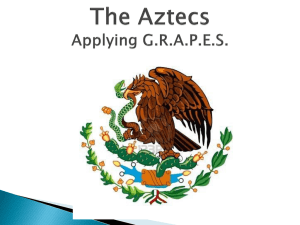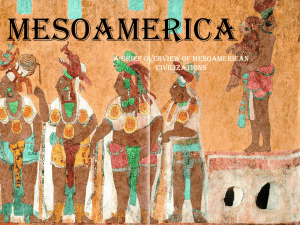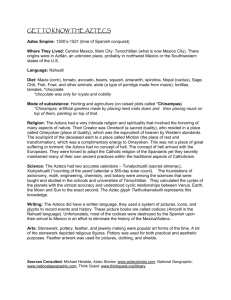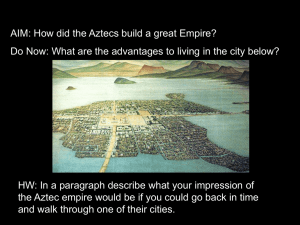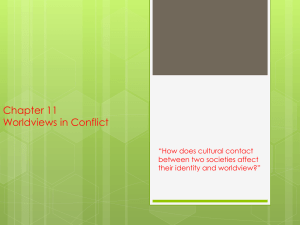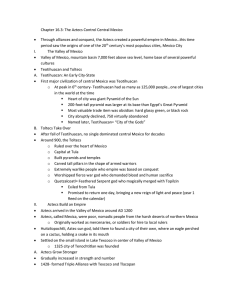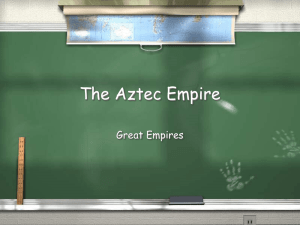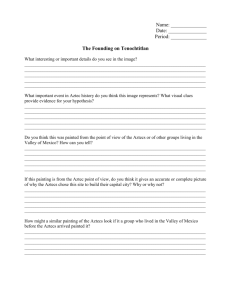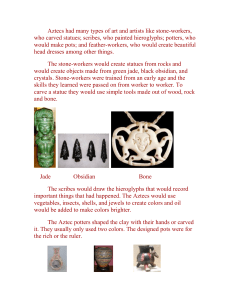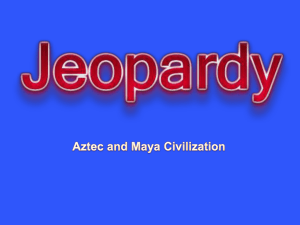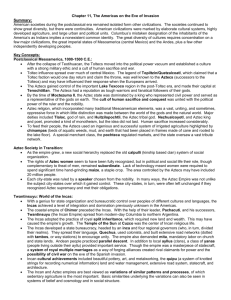Aztec, Inca, Maya SPICE Chart: Civilizations Compared
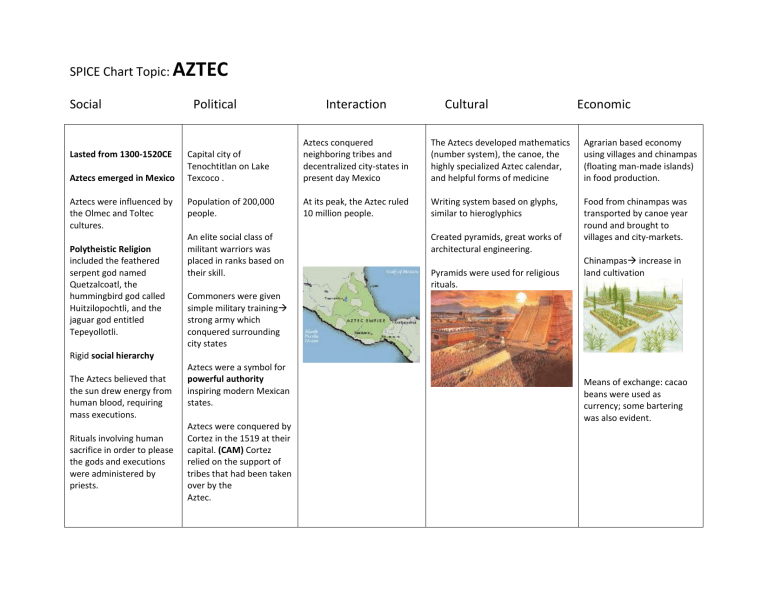
SPICE Chart Topic:
AZTEC
Social Political Interaction Cultural Economic
Lasted from 1300-1520CE
Aztecs emerged in Mexico
Aztecs were influenced by the Olmec and Toltec cultures.
Polytheistic Religion included the feathered serpent god named
Quetzalcoatl, the hummingbird god called
Huitzilopochtli, and the jaguar god entitled
Tepeyollotli.
Rigid social hierarchy
The Aztecs believed that the sun drew energy from human blood, requiring mass executions.
Rituals involving human sacrifice in order to please the gods and executions were administered by priests.
Capital city of
Tenochtitlan on Lake
Texcoco .
Population of 200,000 people.
An elite social class of militant warriors was placed in ranks based on their skill.
Commoners were given simple military training strong army which conquered surrounding city states
Aztecs were a symbol for
powerful authority inspiring modern Mexican states.
Aztecs were conquered by
Cortez in the 1519 at their capital. (CAM) Cortez relied on the support of tribes that had been taken over by the
Aztec.
Aztecs conquered neighboring tribes and decentralized city-states in present day Mexico
At its peak, the Aztec ruled
10 million people.
The Aztecs developed mathematics
(number system), the canoe, the highly specialized Aztec calendar, and helpful forms of medicine
Writing system based on glyphs, similar to hieroglyphics
Created pyramids, great works of architectural engineering.
Pyramids were used for religious rituals.
Agrarian based economy using villages and chinampas
(floating man-made islands) in food production.
Food from chinampas was transported by canoe year round and brought to villages and city-markets.
Chinampas increase in land cultivation
Means of exchange: cacao beans were used as currency; some bartering was also evident.
SPICE Chart Topic:
INCA
Social Political Interaction Cultural Economic
The Incan Empire was located in the Andes
Mountains; it was the most advanced Andean civilization.
It included parts of modern day Peru, Chile,
Bolivia, and Argentina.
Existed from around
1300 C.E until its decline in 1536 C.E due to the invasion of
Francisco Pizzaro.
Important precursor civilizations: Chavin,
Tiawanaku, Moche and
Chimu.
Centralized empire
Based in Cuzco- capital located in modern day
Peru.
Incan Empire rose due its powerful army and growing trade
Government provided
food for its people so that no one starved.
Bureaucracy- allowed central administration of taxes, census facilitated by Chasqui, messengers who delivered messages by running on the exten-sive network of roads and bridges
(communication via infrastructure)
Decline: Francisco Pizarro- overthrew Incan Empire in the early 1500s (PIP)
Roads- 13,000 miles, governmental stability
Interactions focused on trade among people within this vast empire
(see the map below)
>Weaving and metallurgy were prominent cultural achievements of the
Incan
>Made tools and
weapons from copper and bronze for their large
professional army. >Used
gold and silver to make
decorations for their temples and leaders.
>Were able to perform
successful skull surgeries.
>Llama wool and cotton was used by females to produce textiles.
>Quipu was used for recordkeeping.
Technology economic growth: Widespread
irrigation and terrace
farming allowed agriculture to flourish.
Major crops consisted of: corn, sweet potatoes, squash, and beans.
>Road networks
encouraged trade of goods such as gold, silver, and clay pots.
>Relied heavily on
barter system.
SPICE Chart Topic:
MAYA
Be able to visualize the location: Yucatan Peninsula, Mexico
Social Political Interaction Cultural Economic
Populations were generally small
Very few lived permanently in the urban centers
Stratified into five groups
The pre-classical era began near to 2000BCE and lasted until 300CE
It flourished until 900CE.
The post-classical period began in 900CE and lasted to
1500CE
Maya settled in the Yucatan
Peninsula in southern Mexico and dense forests in Guatemala,
Honduras, Belize, and other parts of southern Mexico
>Government based upon small hierarchy and warring city states
>Policies that were made by hereditary rulers
No single king managed to control a large amount of land decentralized and
delegated gov’t (Some aspects of both) Also could be considered a theocracy
Due to religious influence
Main city during the classic period was Tikal.
Temple at Tikal
War broke out between different members of royal families
Made murals and sculptures of rulers and leaders
Influenced by the Olmec
(Neolithic, Olmec statutes)
Review: OL’TEO’MA’TOL’AZ
Invented hieroglyphic
writing system.
The map below shows the
Yucatan Peninsula on the coast of the Gulf of Mexico
Heaven was reserved for those who have been hanged, sacrificed or died during childbirth
Hell was for everyone else.
Religious ceremonies involved dancing, competition, dramatic performances, prayer, and sacrifice, polytheistic
Accurate calendar based on the movement of the sun
Concept of zero
Maize production was their key economic activity
Swidden agriculture/ slash and burn farming
Irrigation systems
Raised farms so canals could reach them.
Traded stone tools, ceramics, salt, obsidian and more.
